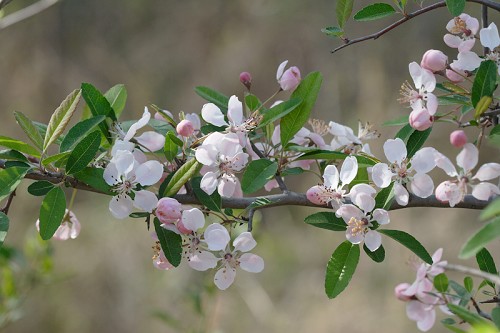Difference between revisions of "Malus angustifolia"
(→Distribution) |
(→Ecology) |
||
| Line 30: | Line 30: | ||
==Ecology== | ==Ecology== | ||
| − | ===Habitat=== <!--Natural communities, human disturbed habitats, topography, hydrology, soils, light, fire regime requirements for removal of competition, etc.--> | + | ===Habitat=== |
| + | Ideal habitats for the ''M. angustifolia'' is in well drained but moist soils in valleys and other slopes, stream beds, borders of woodlands, old fields in the southeast, and even fence rows. It requires full sun for successful fruit and flowers. <ref name= "USDA"> [https://plants.usda.gov/core/profile?symbol=CEAM USDA Plant Database]</ref> | ||
| + | <!--Natural communities, human disturbed habitats, topography, hydrology, soils, light, fire regime requirements for removal of competition, etc.--> | ||
<!--===Phenology===--> <!--Timing off flowering, fruiting, seed dispersal, and environmental triggers. Cite PanFlora website if appropriate: http://www.gilnelson.com/PanFlora/ --> | <!--===Phenology===--> <!--Timing off flowering, fruiting, seed dispersal, and environmental triggers. Cite PanFlora website if appropriate: http://www.gilnelson.com/PanFlora/ --> | ||
<!--===Seed dispersal===--> | <!--===Seed dispersal===--> | ||
| Line 36: | Line 38: | ||
<!--===Fire ecology===--> <!--Fire tolerance, fire dependence, adaptive fire responses--> | <!--===Fire ecology===--> <!--Fire tolerance, fire dependence, adaptive fire responses--> | ||
<!--===Pollination===--> | <!--===Pollination===--> | ||
| − | + | ===Use by animals=== | |
| − | + | Whitetail deer will eat the fruit of the tree, as well as, bobwhites, grouse, pheasants, rabbits, squirrels, opposums, raccoons, skunks, foxes, and other small birds. <ref name= "USDA"> [https://plants.usda.gov/core/profile?symbol=CEAM USDA Plant Database]</ref> | |
| + | ===Diseases and parasites=== | ||
| + | ''M angustifolia'' is prone to fireblight, cedar apple rust, apple scab, canker, scale, borers, and aphids. <ref name= "USDA"> [https://plants.usda.gov/core/profile?symbol=CEAM USDA Plant Database]</ref> | ||
==Conservation and Management== | ==Conservation and Management== | ||
Revision as of 11:15, 24 May 2018
| Malus angustifolia | |
|---|---|

| |
| Photo by the Southeastern Flora Database | |
| Scientific classification | |
| Kingdom: | Plantae |
| Division: | Magnoliophyta - Flowering plants |
| Class: | Magnoliopsida - Dicots |
| Order: | Rosales |
| Family: | Rosaceae |
| Genus: | Malus |
| Species: | M. angustifolia |
| Binomial name | |
| Malus angustifolia Michx. | |

| |
| Natural range of Malus angustifolia from USDA NRCS Plants Database. | |
Contents
Taxonomic Notes
Synonym: Pyrus angustifolia (Aiton), Pyrus angustifolia var. spinosa (Rehder) L.H. Bailey
Variety: none
Description
M. angustifolia is a perennial shrub/tree of the Rosaceae family that is native to North America.[1]
Distribution
M. angustifolia is found throughout the southeastern United States; specifically in Florida, Georgia, Alabama, South Carolina, North Carolina, Virginia, Maryland, Pennsylvania, New Jersey, Deleware, West Virginia, Ohio, Kentucky, Tennessee, Arkansas, Mississippi, Louisiana, and Texas.[1]
Ecology
Habitat
Ideal habitats for the M. angustifolia is in well drained but moist soils in valleys and other slopes, stream beds, borders of woodlands, old fields in the southeast, and even fence rows. It requires full sun for successful fruit and flowers. [1]
Use by animals
Whitetail deer will eat the fruit of the tree, as well as, bobwhites, grouse, pheasants, rabbits, squirrels, opposums, raccoons, skunks, foxes, and other small birds. [1]
Diseases and parasites
M angustifolia is prone to fireblight, cedar apple rust, apple scab, canker, scale, borers, and aphids. [1]